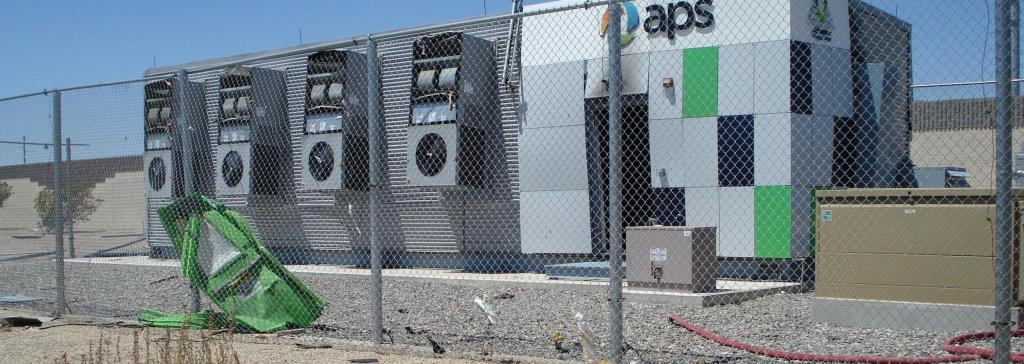
Report: Four Firefighters Injured In Lithium-Ion Battery Energy Storage System Explosion - Arizona
FSRI releases new report investigating near-miss lithium-ion battery energy storage system explosion.
Funded by the U.S. Department of Homeland Security (DHS) and Federal Emergency Management Agency (FEMA) Assistance to Firefighters Grant Program, Four Firefighters Injured In Lithium-Ion Battery Energy Storage System Explosion - Arizona is the first report issued as part of the Study of Firefighter Line of Duty Injuries and Near Misses.
This report details a deflagration incident at a 2.16 MWh lithium-ion battery energy storage system (ESS) facility in Surprise, Ariz. It provides a detailed technical account of the explosion and fire service response, along with recommendations on how to improve codes, standards, and emergency response training to better protect first responders, maintenance personnel and nearby communities.
This report is a first-of-its-kind research effort from FSRI to capture the experience of surviving firefighters to better understand a potentially devastating situation. Four career firefighters with specialized hazardous materials (HAZMAT) training were severely injured in the explosion. They recounted their experience to help inform the report, the investigation team’s understanding of how the fire and gases behaved, and subsequent recommendations for ESS safety training.
“The ability to study lithium-ion battery-related fires on this scale with first-person accounts from the responding firefighters is critically important to protecting the lives of first responders in similar situations. We’re dealing with new technology, which brings about new fire-related hazards. We have an opportunity to learn from this incident and improve future outcomes by sharing resources and enhancing training and safety protocols.”
— Steve Kerber, Vice President, Research and Director of FSRI
Lithium-ion battery ESS facilities have proliferated in recent years, presenting a new challenge for the fire protection community. Sourcing the experiences of the firefighters, FSRI’s report recommends new standards and codes for ESS sites, research programs, and curricula. Recommendations include HAZMAT training with an emphasis on ESS safety, remotely accessible gas monitoring systems, explosion prevention protection, and full-scale testing research to understand the most effective and safest tactics for fire service response to lithium-ion battery ESS incidents.
Abstract
On April 19, 2019, one male career Fire Captain, one male career Fire Engineer, and two male career Firefighters received serious injuries as a result of cascading thermal runaway within a 2.16 MWh lithium-ion battery energy storage system (ESS) that led to a deflagration event.
The smoke detector in the ESS signaled an alarm condition at approximately 16:55 hours and discharged a total flooding clean agent suppressant (Novec 1230). The injured firefighters were members of a hazardous materials (HAZMAT) team that arrived on the scene at approximately 18:28 hours. The HAZMAT team noted low-lying white clouds of a gas/vapor mixture issuing from the structure and nearby components and drifting through the desert. The team defined a hot zone and made several entries into the hot zone to conduct 360-degree size-ups around the ESS using multi-gas meters, colorimetric tubes, and thermal imaging cameras (TICs). The team detected dangerously elevated levels of hydrogen cyanide (HCN) and carbon monoxide (CO) during each entry. The team continued to monitor the ESS and noted the white gas/vapor mixture stopped flowing out of the container at approximately 19:50 hours.
The HAZMAT leadership developed an incident action plan with input from a group of senior fire officers and information about the ESS provided by representatives from the companies that owned, designed, and maintained the ESS. The HAZMAT team made a final entry into the hot zone and found that HCN and CO concentrations in the vicinity of the ESS were below an acceptable threshold. In following with the incident action plan, the team opened the door to the ESS at approximately 20:01 hours. A deflagration event was observed by the firefighters outside the hot zone at approximately 20:04 hours. All HAZMAT team members received serious injuries in the deflagration and were quickly transported to nearby hospitals. Note: The lithium-ion battery ESS involved in this incident was commissioned prior to release of a first draft of the current consensus standard on ESS installations, NFPA 855; the design of the ESS complied with the pertinent codes and standards active at the time of its commissioning.
Research Project: Study of Firefighter Line of Duty Injuries and Near Misses
Report Title: Four Firefighters Injured In Lithium-Ion Battery Energy Storage System Explosion - Arizona
Report Authors: Mark McKinnon, Sean DeCrane and Steve Kerber
Download the Report: https://dx.doi.org/10.54206/102376/TEHS4612
Release Date: July 28, 2020

